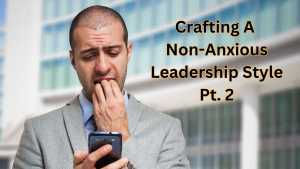Crafting A Non-Anxious Leadership Style Pt. 2
- Josh Cole

- Jun 14, 2023
- 3 min read

Do you constantly second-guess your decisions and push your team to work longer hours?
Is your team too afraid to speak up or ask questions for fear of displeasing you?
That anxiety is having a direct impact on the performance of your team.
Projects are left incomplete. Customer service suffers.
Team morale takes a hit.
Crafting a non-anxious leadership style can reverse the chaos that anxiety is causing your teams.
In the last blog post, I focused on the “leading yourself” side of crafting a non-anxious leadership style. I shared insights into reducing the anxiety that all leaders feel.
In this sequel post, we will shift our focus to the “leading others” side of crafting a non-anxious leadership style. We’ll look at how slowing down and embracing vulnerability are essential components of creating an anxiety-free team environment.

Slowing Down To Create Authentic Leadership
Scheduling time for reflection–slowing down–lessens anxiety in leadership.
I know, it seems impossible to slow down.
It feels like slowing down would mean poor performance.
And yes, slowing your leadership pace may initially cause a dip in productivity.
But slowing down intentionally to discover what you feel and think and to make decisions in depressurized moments produces the greatest results throughout your leadership journey.

Slowing down is the only way to gain the self-awareness that allows authenticity.
This is why I think that slowing down for reflection is a “leading others” step.
It’s strategically preparing you to lead your teams effectively.
You’re not slowing to reflect just for you. Slow down for your team.
A lack of self-awareness creates anxiety since the body interprets unfinished business (like unprocessed feelings, decisions that are being avoided, priorities that haven’t been defined, or desires that are being ignored) as a threat to its safety.
And that anxiety causes leaders to hem and haw, speak ambiguously, waffle on decisions, or hide information that would empower the team: the hallmarks of inauthentic and/or guarded leaders.
Self-awareness gives leaders the data they need to lead calmly.
Non-anxious and authentic leaders routinely pause to take a look at what they are mad at, sad about, and glad about.
They notice how their internal responses are helping or hindering their work as a leader.
Why are you avoiding a policy decision?
When you know, you can face it and give the team the direction it needs.
Why aren’t you holding your team to consistent standards?
Why are you honest and confident with some of your co-workers and not with others?
When you pause to reflect, you become aware of the anxieties inside of you that are guiding your leadership.
Then you are empowered to conquer those anxieties and lead vulnerably.

Embracing Vulnerability
Learning how to lead in a vulnerable way greatly reduces the anxiety leaders produce on their teams.
Now, I’m not talking about sharing information that should be reserved for your therapist. (Awkward!)
And I’m not talking about being mousy or thin-skinned.
I’m talking about acknowledging real challenges or elephants in the room, getting to know team members and letting them get to know you, and verbalizing your emotions appropriately when you talk with your team.
Why should leaders be vulnerable?
Appropriate vulnerability increases the trust your team can have in you because it makes you more approachable.
Human beings are not inspired by machines. They want to follow a human.
Humans are flawed. Humans have emotions. Humans fear uncertainties.
If you will not admit to your failures, the difficulties of a situation, the problems you have with an employee’s attitude or performance, or your wishes and hopes, your team members will not relate to you as a human.
And if they can’t relate to you as a human being, they will be suspicious of your motivations and even your competence.

Suspicion heightens anxiety in the team dynamic.
Teams feel calmer and think better when they are led by a leader that they relate to and trust, a leader that has learned to embrace vulnerability.
LinkedIn has a great article on effective vulnerable leadership and how it improves teams.
Read it here.
Coaching can help you craft a non-anxious leadership style.
If you want help slowing down or developing vulnerability that creates calm leadership, please don’t hesitate to reach out for coaching here!
I’m here to provide coaching support so you can build a strong foundation for success.



Comments